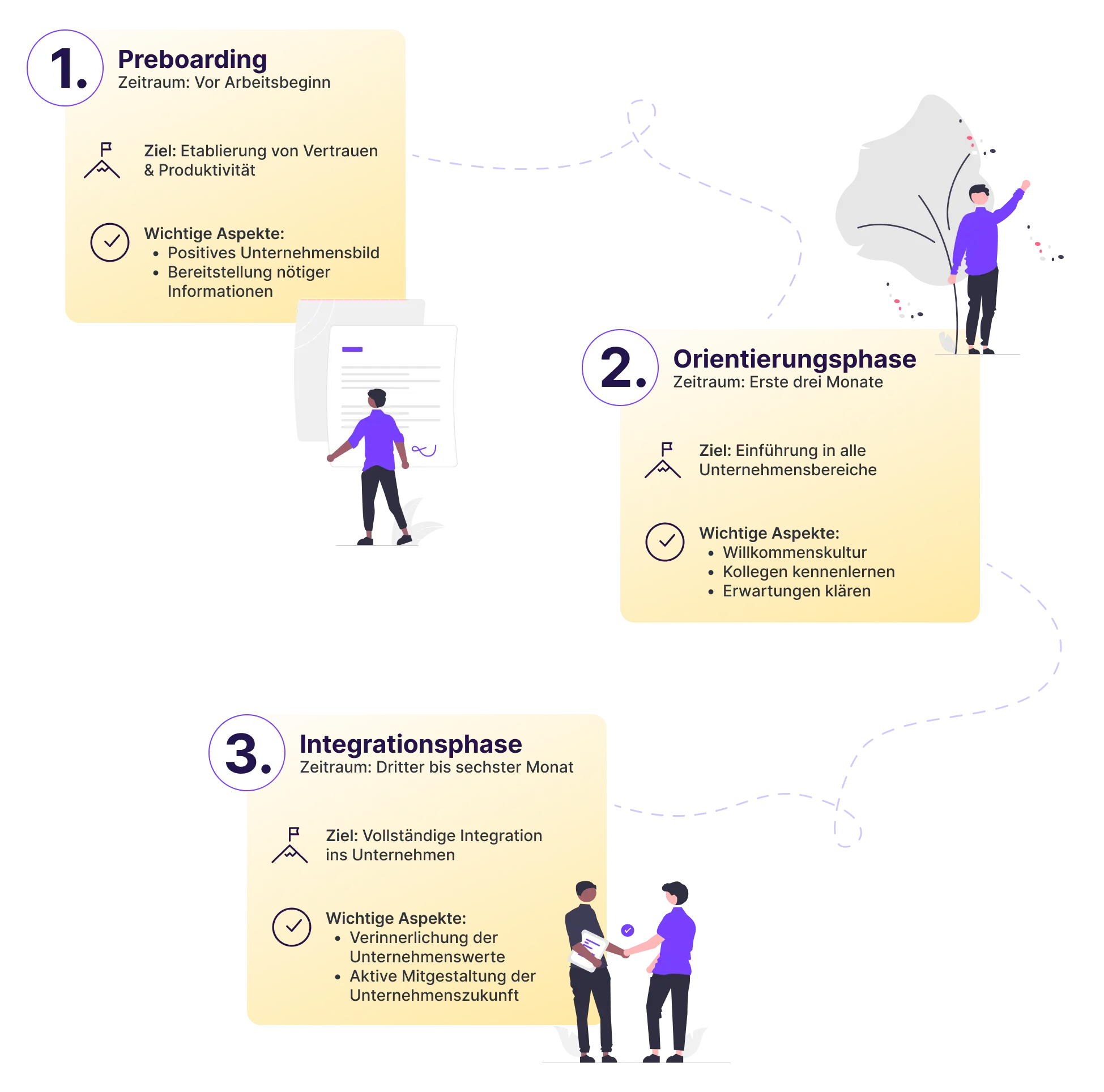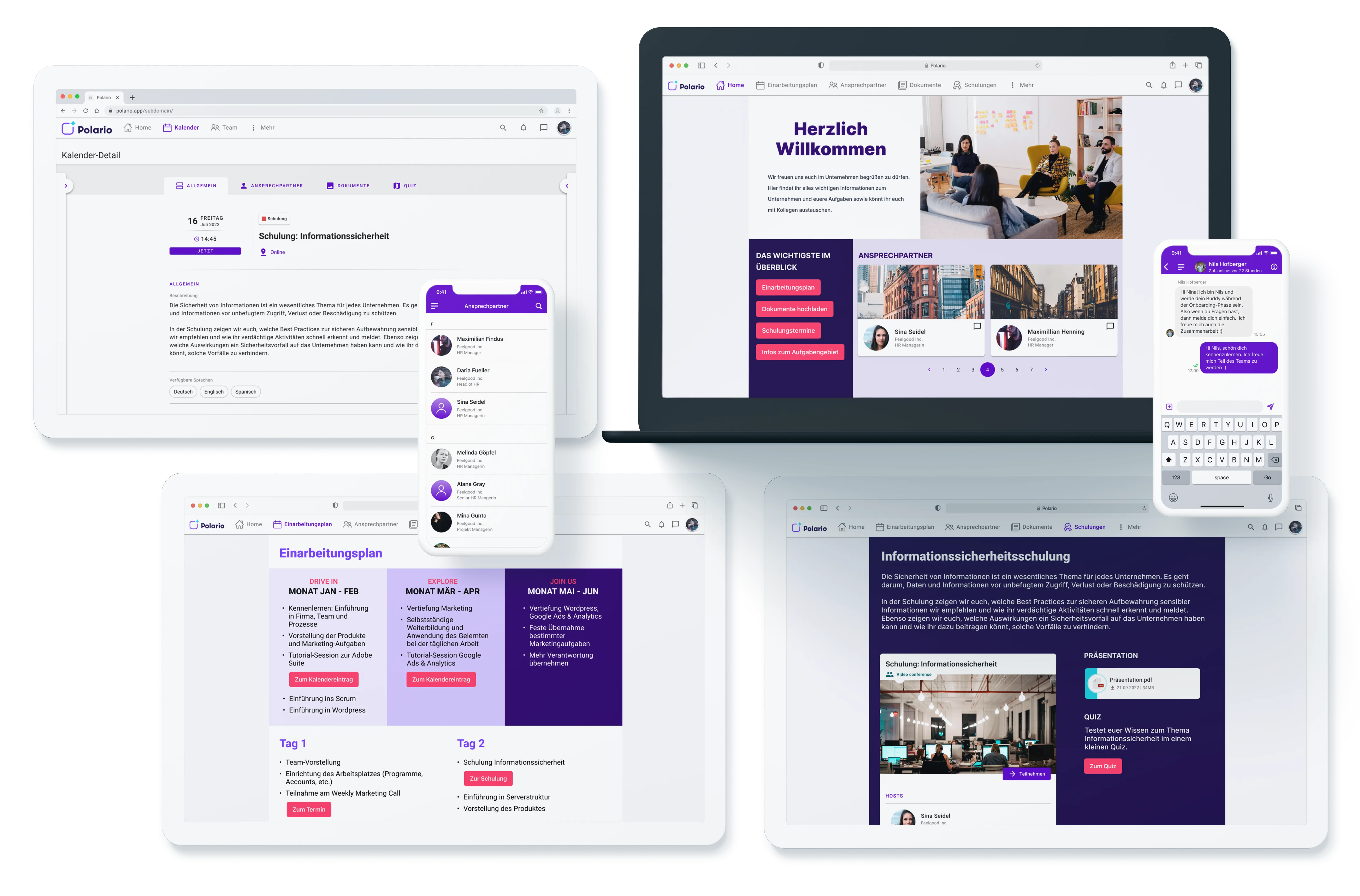In the digital era, where first impressions are often the most crucial, the onboarding process has taken on a whole new meaning. It is no longer just a “nice-to-have” but a crucial element for the success of a company. The Onboarding Survey by Haufe provides revealing data on this: 36% of companies experience terminations before new employees have even reached their desks. In 56% of these cases, it is unmet expectations that lead to this quick departure.
But there are also positive trends: an impressive 84% of companies tackle onboarding before the first day of work. This underscores the importance of early and structured entry.
Let’s dive deeper into the world of the onboarding process, highlighting everything from the basics to current trends to innovative strategies and tools.
Definition: What is the onboarding process?
The onboarding process goes far beyond simply “welcoming” a new employee. It is a carefully planned process that ensures new team members are not only efficiently introduced to their role, but also feel an integral part of the organization. The goal? Create a seamless connection between the fresh talent and the existing company culture to ensure harmonious team integration.
A successful onboarding process goes through various phases: from preparation before the first day of work, through induction, to ongoing support and integration into the corporate world. It’s not just about providing employees with the resources and information they need, but also making them feel like an indispensable part of the overall structure.
The 3 key phases of the onboarding process
The onboarding process of new talent is like an exciting journey. As with any journey, there are milestones that define the path to the destination.

1. Preparation Phase - The Preboarding
Even before the new team member officially starts, the journey begins: with the preparation phase, also called preboarding. From the signing of the contract to the first day of work, the company does everything it can to lay the foundation for a trusting and productive working relationship. It is not only a matter of painting a positive picture of the company, but also of providing the newcomer with all the necessary information. An impressive figure from the Haufe onboarding survey underscores the importance of this phase: 84% of companies make contact at this early stage and ensure a structured entry.
2. Orientation Phase - The First Steps
The early days in a new company are formative. In the first three months, the so-called orientation phase, the new team member gets to know the company in all its facets. The starting signal is given with a warm welcome, meeting the colleagues and a first exchange with the supervisor. In the following weeks, the knowledge about products and services deepens. The first more responsible tasks are assigned and mutual expectations are defined in a dialog with the supervisor.
3. Integration phase - From newcomer to insider
After the first orientation weeks, the deeper dive begins: the integration phase. It extends from the third month to the sixth month and in some cases can even last until the twelfth month. This is where the new team member becomes a full part of the company. It is the time when a fresh face becomes a trusted colleague who not only lives the company values, but also actively contributes to the future of the company.
Current trends in onboarding
The days when onboarding simply meant a brief introductory meeting and a tour of the office are over. In a working world characterized by digitalization and constant change, the onboarding process has also evolved rapidly. Let’s take a look together at the current trends in onboarding.
Digitization meets onboarding: Remote as the new standard
Advancing digitization has redefined the onboarding process, with the Corona pandemic accelerating the trend toward remote onboarding. Although the Haufe Onboarding Study reveals that 64% of companies have not yet introduced any specific measures for remote onboarding, 36% are already increasingly relying on this approach. This underscores the relevance of digital solutions to ensure a smooth onboarding experience for employees, regardless of their location. Here are some possibilities:
Virtual tours
Give a first glimpse into the office environment and culture, without the travel expenses.
Online trainings
Enable flexible learning and familiarization with new tasks and tools.
Digital welcome packages
Provision of all information with one click, always and everywhere available.
Interactive webinars
Opportunity to network and get to know colleagues in a virtual space.
Digital mentoring programs
Support and guidance from experienced colleagues via digital channels.
More than just a job: Focus on culture and values
Today’s onboarding goes beyond simply providing job details. It’s about communicating the heart of the company: its culture and values. To help new talent know not only WHAT they are doing, but also WHY, the following approaches are effective:
Workshops on corporate values
Interactive sessions in which the company's core values are discussed and illustrated in real work contexts. This enables employees to internalize the values in their daily actions.
Team events
Joint activities that not only strengthen the team spirit but also convey the corporate culture in a relaxed atmosphere. Whether team-building activities or joint celebrations - such events promote a sense of togetherness and identification with the company.
Mentoring Programs
Experienced colleagues accompany and support the newcomers during their induction phase. Direct interaction allows corporate values and culture to be communicated first-hand, accelerating understanding and integration into the corporate community.
Onboarding à la carte: Individuality counts
Every person ticks differently – and that is also reflected in onboarding. Companies are therefore increasingly relying on customized onboarding plans. These are based on the individual needs and abilities of the newcomers. Continuous feedback and flexible adjustments thus ensure that every new employee gets the best possible start.
The indispensable role of onboarding in employee retention
The relationship between a company and its employees can be compared to a seedling: it must be nurtured from the very beginning in order to flourish. The onboarding process plays a central role in this. Because this lays the foundation for a long-lasting bond. It is not just a matter of giving the new recruits the necessary tools for their tasks, but also of integrating them emotionally into the company.
Interestingly, Haufe’s onboarding survey shows that while 78% of companies consider social and cultural integration to be particularly important, only 61% actually offer mentoring or sponsorship programs. So there is still a lot of potential here to strengthen the loyalty of new employees right from the start
A carefully designed onboarding process is more than just an induction program. It is the first step in what we hope will be a long and productive relationship between employees and the company. By making targeted investments in this process, companies can not only shorten the onboarding period, but also strengthen employee engagement and retention right from the start. In today’s fast-paced work world, this is an invaluable advantage.
Onboarding Apps: The Must-Have for the Modern Onboarding Process
Thanks to the ubiquity of smartphones, onboarding apps have become a game-changer in new employee onboarding. These apps are not only practical helpers that centralize all onboarding activities, but also score points for their user-friendly handling. But what makes onboarding apps so indispensable in the modern onboarding process?
Everything in one place
Whether it's company policies, training materials, or team information, employees have everything they need at their fingertips in onboarding apps.
Communication promotion
A key benefit of onboarding apps is seamless communication. Thanks to integrated chats or channels, newcomers can network directly with their colleagues, clarify questions and obtain valuable feedback.
Learning by interaction
Many of these apps offer interactive tutorials. This allows employees to familiarize themselves with the company's systems and processes in a fun and efficient way.
Feedback on the go
With built-in feedback tools, newcomers can share their impressions and suggestions. This enables HR teams to constantly refine and adapt the onboarding process.
Integration with other tools
Another plus is the ability to pair onboarding apps with other HR tools. This not only facilitates data exchange, but also automates many processes, saving time and resources.
Modern onboarding hurdles and how to overcome them
1st Hurdle: Virtual onboarding
Remote working and globally distributed teams are no longer a rarity. This also means that traditional “on-site” onboarding is often no longer sufficient. With VR technologies and specialized onboarding platforms, companies can offer virtual office tours and interactive training. This gives new employees, even from a distance, an authentic feel for the company.
2nd Hurdle: Communicating the Company's Values
A company lives from its culture and values. Conveying these is essential so that newcomers really feel they belong. Workshops that focus on the company values and buddy programs in which newcomers are accompanied by experienced colleagues are worth their weight in gold here.
3rd Hurdle: Flood of information
The first day at a new company can be overwhelming, especially when faced with a flood of information. To avoid this, more and more companies are turning to e-learning platforms and staggered information releases. This way, new employees can learn at their own pace and have access to the resources they need at any time.
4th Hurdle: Employee retention beyond onboarding
A successful start is important, but the new talent’s bond with the company should be strengthened beyond that. Regular feedback meetings and offers for further training are the key here. When employees feel that their career prospects are being fostered within the company, their satisfaction and loyalty also increase.
Conclusion: The future of onboarding and the role of HR
The future of onboarding is dynamic, digital, and deeply embedded in corporate culture. In an ever-changing workplace, it is imperative that HR teams are at the forefront of ensuring that the onboarding process meets the needs of both the business and the employee. Integrating technology, communicating corporate values, and creating an inclusive culture are just a few of the many aspects HR must consider.
The challenges and solutions presented show that a forward-looking onboarding process requires a combination of technological innovation and human touch. For HR, this means staying current, adapting best practices, and viewing the onboarding process as a continuous journey. Such an approach will not only lead to more satisfied employees, but also lay the foundation for long-term retention. It’s clear: HR plays a critical role in shaping the onboarding future.



